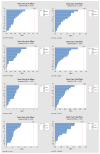Stability of Cocaine, Opiates, and Metabolites in Dried Saliva Spots
- PMID: 35163906
- PMCID: PMC8839019
- DOI: 10.3390/molecules27030641
Stability of Cocaine, Opiates, and Metabolites in Dried Saliva Spots
Abstract
Drug abuse still represents a global problem, and it is associated with an increased risk of diseases, injuries, and deaths. Cocaine (COC) and opiates are the most abused drugs and account for a significant number of fatalities. Therefore, it is important to develop methods capable of effectively identifying and quantifying these substances. The present study aims to evaluate the long-term stability of COC, ecgonine methylester (EME), benzoylecgonine (BEG), cocaethylene (COET), norcocaine (NCOC), morphine (MOR), codeine (COD) and 6-monoacetylmorphine (6-MAM) in oral fluid samples. The analytes of interest were isolated from the matrix (50 µL) using the dried saliva spots (DSS) sampling approach and were subsequently analyzed by gas chromatography coupled with tandem mass spectrometry (GC-MS/MS). The parameters that could influence the stability of the target compounds were studied, and these were storage temperature, light, use of preservatives (and respective concentrations), and time. The effects of each parameter were evaluated using the design of experiments (DOE) approach. The stability of the target analytes was improved when the DSS were stored at room temperature, in the presence of light and using 1% sodium fluoride. The best conditions were then adopted for the DSS storage and long-term stability was assessed. COD was only stable for 1 day, EME was stable for 3 days, COC, COET, NCOC and 6-MAM were stable for 7 days, MOR for 14 days and BEG remained stable throughout the study (136 days). This is the first study that evaluates the stability of these compounds in oral fluid samples after application in DSS cards, and optimizes the conditions in order to improve their stability.
Keywords: GC–MS/MS; cocaine; dried saliva spots; opiates; oral fluid; stability.
Conflict of interest statement
The authors declare that they have no conflict of interest or financial involvement regarding this submission.
Figures






Similar articles
-
Simultaneous determination of cocaine, ecgonine methyl ester, benzoylecgonine, cocaethylene and norcocaine in dried blood spots by ultra-performance liquid chromatography coupled to tandem mass spectrometry.Forensic Sci Int. 2019 May;298:408-416. doi: 10.1016/j.forsciint.2019.03.026. Epub 2019 Mar 23. Forensic Sci Int. 2019. PMID: 30954922
-
Quantitation of cocaine, benzoylecgonine, cocaethylene, methylecgonine, and norcocaine in human hair by positive ion chemical ionization (PICI) gas chromatography-tandem mass spectrometry.J Anal Toxicol. 2000 Oct;24(7):489-95. doi: 10.1093/jat/24.7.489. J Anal Toxicol. 2000. PMID: 11043651
-
Immunological screening of drugs of abuse and gas chromatographic-mass spectrometric confirmation of opiates and cocaine in hair.J Chromatogr B Biomed Sci Appl. 1999 Mar 5;724(1):9-21. doi: 10.1016/s0378-4347(98)00531-3. J Chromatogr B Biomed Sci Appl. 1999. PMID: 10202953
-
Rapid assay of cocaine, opiates and metabolites by gas chromatography-mass spectrometry.J Chromatogr. 1992 Sep 16;580(1-2):43-61. doi: 10.1016/0378-4347(92)80527-w. J Chromatogr. 1992. PMID: 1400832 Review.
-
Potential use of a dried saliva spot (DSS) in therapeutic drug monitoring and disease diagnosis.J Pharm Anal. 2022 Dec;12(6):815-823. doi: 10.1016/j.jpha.2021.11.001. Epub 2021 Nov 8. J Pharm Anal. 2022. PMID: 36605582 Free PMC article. Review.
Cited by
-
Evaluation of Antipsychotic Drugs' Stability in Oral Fluid Samples.Molecules. 2023 Feb 21;28(5):2030. doi: 10.3390/molecules28052030. Molecules. 2023. PMID: 36903275 Free PMC article.
-
Determination of drugs of abuse in oral fluid using dried oral fluid spot assisted by 24-well plate and LC-MS/MS.Bioanalysis. 2025 May;17(9):595-605. doi: 10.1080/17576180.2025.2506348. Epub 2025 May 22. Bioanalysis. 2025. PMID: 40401753 Review.
-
Rapid Detection of Amitriptyline in Dried Blood and Dried Saliva Samples with Surface-Enhanced Raman Spectroscopy.Sensors (Basel). 2022 Oct 28;22(21):8257. doi: 10.3390/s22218257. Sensors (Basel). 2022. PMID: 36365956 Free PMC article.
-
Evaluation of Antiepileptic Drugs' Stability in Oral Fluid Samples.Pharmaceuticals (Basel). 2025 Jul 17;18(7):1049. doi: 10.3390/ph18071049. Pharmaceuticals (Basel). 2025. PMID: 40732336 Free PMC article.
-
Advances on Bioanalysis: Recent Approaches in the Determination of Biomarkers, Drugs of Abuse and Medicines.Molecules. 2022 May 17;27(10):3188. doi: 10.3390/molecules27103188. Molecules. 2022. PMID: 35630663 Free PMC article.
References
-
- European Monitoring Centre for Drugs and Drug Adiction Perspectives on Drugs—Emergency Health Consequences of Cocaine Use in Europe. [(accessed on 13 October 2021)]. Available online: https://www.emcdda.europa.eu/system/files/publications/2725/Cocaine%20re....
-
- European Monitoring Centre for Drugs and Drug Addiction (EMCDDA) European Drug Report 2019: Trends and Developments. [(accessed on 21 June 2021)]. Available online: https://www.emcdda.europa.eu/system/files/publications/11364/20191724_TD....
-
- European Monitoring Centre for Drugs and Drug Adiction European Drug Report 2021: Trends and Developments. [(accessed on 15 October 2021)]. Available online: https://www.emcdda.europa.eu/system/files/publications/13236/TDAT20001EN....
MeSH terms
Substances
Grants and funding
LinkOut - more resources
Full Text Sources
Miscellaneous

